#Russian locomotive
Explore tagged Tumblr posts
Text
NWR #20 "Andreyev"

Built in 1934 at Voroshilovgrad Locomotive Works for Russian Railways, Andreyev, AKA the AA20, was built as the longest rigid-frame locomotive in Europe, and was numbered AA20-1. Andreyev was tested in the USSR, but has several problems running, including being too heavy and destroying points, derailing on curves, and being a bad steamer. In 1935, Sir Topham Hatt 1st was looking for a new engine, and was given a cheap offer to have the AA20 on sodor by Russian Railways. Seeing potential in the large engine, he purchased him and sent him to sodor, where he was modified to be more efficient and lightweight. He was later given the number 20 in the NWR's 2019 renumbering, after previously sporting his original number. He now works at the Kirk Ronan branch line, hauling heavy goods and small passenger trains from Kirk Ronan to Crovan's Gate and back again. He also sometimes takes trains to the Big City near Kirk Ronan, often interacting with the many tugboats patrolling and working the waters there.
#thomas and friends#thomas and friends au#thomas the tank engine#au#ttte#ttte oc#ttte AU#AA20#AA20-1#AA20 locomotive#Russian locomotive#Andreyev#Andreyev TTTE#oc
2 notes
·
View notes
Text

Little study I did last year and couldn't finish
#thomas and friends#ttte oc#ivan the siberian engine#thomas and friends oc#russian decapod#locomotive
75 notes
·
View notes
Text

We had style then - a 1930s era Soviet 2-3-2B streamlined locomotive.
#vintage trains#vintage locomotives#locomotives#trains#steamliners#streamline locomotives#streamline design#vintage train travel#russian design#soviet russia#soviet#soviet design#the 30s#the 1930s#streamlined trains
20 notes
·
View notes
Text
Russia. ER 797-15 steam locomotive at the station "Taganrog-II" Таганрог, паровоз Эр 797-15
#2013#autumn#locomotive#railroad#railway#september#taganrog#вагоны#железная дорога#локомотив#осень#паровоз#паровоз эр#паровоз эр 797-15#сентябрь#таганрог#Canon#Canon EOS 550D#russia#flickr#россия#russian tumblr#русский tumblr
10 notes
·
View notes
Text
Random Trains I Found Part 1:
So, I've put off writing my myriad of WIPs for a bit to spend some time just... looking at trains. Reconnecting with them. Hunting out ideas for the future and being amazed by the past. And here's a few of my absolute favourite random, insane trains I've found so far:
NGR Class D1:
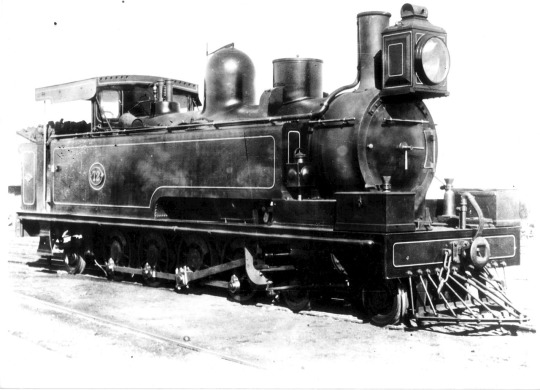
This right here was the first 4-8-2 ever built - and it's an absolutely massive tank engine from South Africa. It was built to the 3ft 6in Cape Gauge and it began running in 1888. Take a moment for that to settle in - 1888. The USA didn't run a 4-8-2 on it's network until 1911, a good 20+ years later!
Russian Class Kh:

It's a 2-8-0 class built in the USA for Russia that had examples sold to Japan with the last example preserved in China. I personally like these engines because they really do tell us so much about how much the world changed - they began life in 1895, and somehow (I would love to know how if anyone has any information) one ended up in a river in Jilin Province, China. It was probably WWII, but all the same, these engines went places!
Prussian P8 Class:
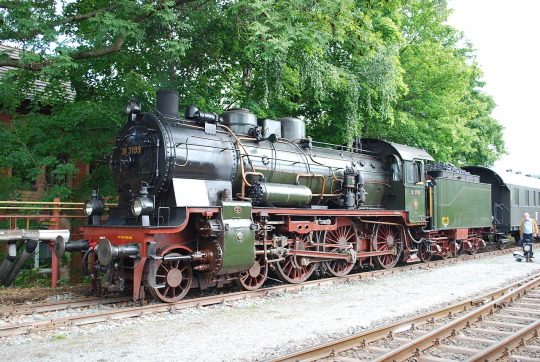
These engines started life in 1908 and weren't retired until 1981 in Poland at the latest - and if that isn't an opening to an epic class of locomotive, I don't know what is! Roughly 3900 of these machines were built, making it potentially the single largest class of passenger engine in the world and they ended up just about everywhere in Europe, from France to Norway to Romania, where a number (200) were built under license. And the reason they lived so long? They were simple, strong machines.
GWR 2600 'Aberdare' Class:
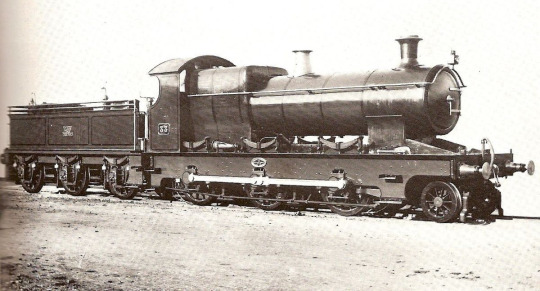
Honestly, I just like these because they look so odd. Like, these are GWR 2-6-0s that look like a City or a Bulldog class. They have the double frames and the coupling rods of a 4-4-0 - and that's because they were introduced in 1900. They did manage to make it to 1949 hauling coal trains, but the GWR had already been withdrawing them in the 1930s, as they did with their older stock. I wish one had been preserved, they'd be so cool to look at!
NGR Class C:
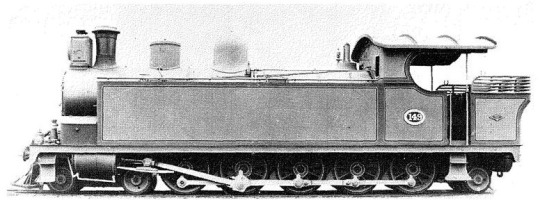
Last but certainly not least, these behemoths of South Africa once again prove that somehow, the former Cape Colony was at the forefront of wheel arrangement innovation. It's a 4-10-2T. It was built in 1899, alongside the GWR Bulldog class! These things were massive... and eventually rebuilt to 4-8-2T locomotives. But there were 137 of them built, making them the most numerous of the 4-10-2 type locomotive ever constructed.
I want all of these engines. I would love to know more about them, I would love to own one (in model form) and I am going to love continuing my journey through railway history to find more random, interesting locomotives to share.
And as usual, all images belong to their respective owners.
#weirdowithaquill#railways#real railway stuff#real world trains#South African Railways#Prussian P8 locomotive#Russian Kh locomotive#gwr#Aberdare Class#real trains are so cool#And leaving my UK-centric railway view to explore is a lot of fun!#random railways#random thoughts
23 notes
·
View notes
Video
P36-0050 Crimean Peninsula por Barry C. Austin Por Flickr: Run-pasts on route from Vladislavovka to Feodosiva 22 September 1993
9 notes
·
View notes
Link
An explosion in the Russian border region of Bryansk derailed a freight train on Monday, authorities said.
Local governor Alexander Bogomaz said an explosive device went off along the Bryansk-Unecha line, 60km from Ukraine.
The incident, which occurred at 10:17 Moscow time (07:17 GMT), saw the locomotive catch fire and seven freight wagons derailed, Russian Railways said.
The region - which borders Ukraine and Belarus - has seen acts of sabotage since Russia invaded Ukraine.
The train was reportedly carrying oil products and timber. No injuries were reported.
#train#freight train#derailment#explosive device#train line#tracks#raillway#locomotive engine#fire#train wreck#wagon cars#Russian Railways#sabotage#oil products#timber#war#Ukraine War#Russia#news#world news
0 notes
Text



























"Рускеальский экспресс" это регулярный пассажирский ретропоезд курсирующий ежедневно на паровозной тяге. Последний регулярный пассажирский поезд на паровозной тяге курсировал в конце 70-х годов XX века. "Рускеальский экспресс" состоит из семи вагонов включая вагон-ресторан. В первый рейс поезд отправился 1 июня 2019 года. Больше 50 тысяч туристов побывали в вагонах Рускеальского экспресса за первый же год работы.
Поезд «Рускеальский экспресс» связал берег Ладожского озера и рускеальское месторождение, а внутреннее убранство поезда оформлено в стилистике Николаевского экспресса, так распространенной на рубеже XIX–XX веков. Светильники, отделка, обои и мебель воссоздают атмосферу тех вагонов, пассажирами которых были последний российский император и его семья. В купе – большой стол и удобные диванчики с пуфиками, проводники одеты в стилизованную под старину форму. Особенностью поезда служит оригинальное фотокупе, где оборудована специальная система для моментального фотоснимка.
Кстати, современная железная дорога от платформы Сортавала до горного парка «Рускеала» полностью повторяет маршрут, по которому 200 лет назад везли к берегу Ладожского озера рускеальский мрамор для Исаакиевского собора.
"Ruskeala Express" is a regular retro passenger train running daily on a steam locomotive. The last regular passenger train on a steam locomotive ran in the late 70s of the 20th century. "Ruskeala Express" consists of seven cars including a restaurant car. The train departed on its maiden voyage on June 1, 2019. More than 50 thousand tourists visited the cars of the Ruskeala Express during the first year of operation.
The train "Ruskeala Express" connected the shore of Lake Ladoga and the Ruskeala deposit, and the interior of the train is decorated in the style of the Nikolaevsky Express, so common at the turn of the 19th and 20th centuries. Lamps, decoration, wallpaper and furniture recreate the atmosphere of those cars, the passengers of which were the last Russian emperor and his family. In the compartment there is a large table and comfortable sofas with ottomans, the conductors are dressed in a stylized antique uniform. The train's special feature is its original photo compartment, which is equipped with a special system for instant photography.
By the way, the modern railway from the Sortavala platform to the Ruskeala Mountain Park completely repeats the route along which Ruskeala marble for St. Isaac's Cathedral was transported to the shore of Lake Ladoga 200 years ago.
Источник://t.me/krasota_zemli, //pikabu.ru/tag/Рускеальский% 20 экспресс/h, //naparovoze.ru/zima-ruskeala-iz-spb, //35photo.pro/ tags/Рускеала/, /35photo.pro/photo_7531702/#author/7531702, //vk.com/ruskealexpress?to=L3J1c2tlYWxleHByZXNzPw, //www. sputnik8.com/ru/st-petersburg/sights/ruskealskiy-ekspress /info.
#nature#nature aesthetic#Russia#Karelia#landscape photography#winter#snow#forest#retro train#Ruskeala Express#locomotive#rails#New Year's decor#interior design#tourism#природа#Россия#Карелия#Пейзаж#лес#зима#снег#поезд#рельсы#ретропоезд#Рускеальский экспресс#паровоз#новогодний декор#интерьер
205 notes
·
View notes
Text
Round 2 - Arthropoda - Branchiopoda
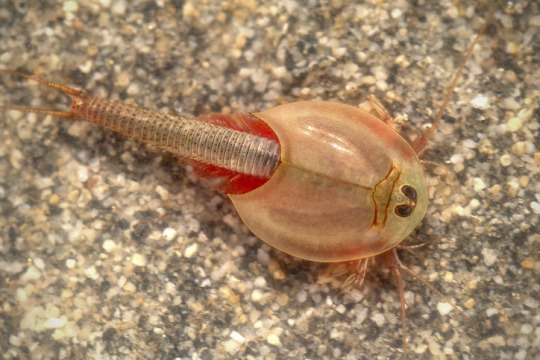
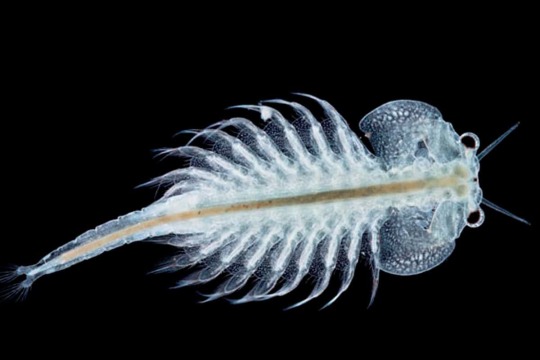
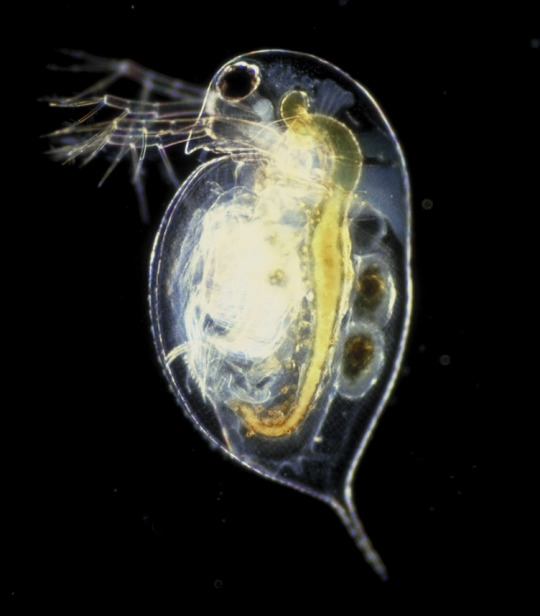

(Sources - 1, 2, 3, 4)
Branchiopoda is a class of small, mainly freshwater crustaceans that feed on plankton and detritus. They are comprised of 9 orders: Anostraca (“Fairy Shrimp”), Anomopoda (“Water Fleas”), Ctenopoda (also “Water Fleas”), Cyclestherida (“Clam Shrimp”), Laevicaudata (also “Clam Shrimp”), Spinicaudata (also “Clam Shrimp”), Haplopoda (“Predatory Water Fleas”), Onychopoda (“Water Fleas” again), and Notostraca (“Tadpole/Shield Shrimp”).
Branchiopods are found mainly in freshwater, including temporary pools and hypersaline lakes, and some in brackish water. Those that live in temporary pools are known for having eggs that can dry out for long periods of time and hatch once they are submerged in water, as an adaptation to drought. Only two families, one in Onychopoda and one in Ctenopoda, contain marine species. Most eat detritus or plankton, catching them in the setae on their appendages. Notostracans are opportunistic omnivores that will feed on algae, bacteria, other branchiopods like Anostracans, and even small fish.
Branchiopods are characterized by the presence of gills on many of the animals’ appendages, including the mouthparts. Most have compound eyes and a carapace. In the Clam Shrimp, the carapace prevents the use of the legs for swimming, so the antennae are used for locomotion instead, as they are in nauplius larvae.
The oldest known branchiopod was Rehbachiella kinnekullensis of the Upper Cambrian. Notostracans in particular have a good fossil record, with the oldest known species being Strudops goldenbergi from the Late Devonian. Notostracans are often described as “Living Fossils” due to their lack of major morphological change over 250 million years.
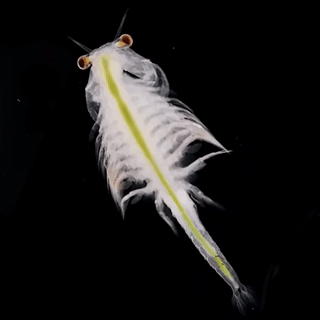
Propaganda under the cut:
Both Triops (a genus of Notostracan) and Artemia (a genus of Anostracan) make popular low maintenance aquarium pets, respectively called “Dinosaur Shrimp” and “Sea-monkeys” in the pet trade.
Triops longicaudatus helps control the West Nile virus, as they prey on Culex mosquito larvae.
In Japan, Triops cancriformis are used as biological pest control, kept in rice paddies to eat weeds.
Most branchiopods feed on small plankton and detritus, but some are large(r) predators, and Notostracans aren’t the only ones! The Giant Fairy Shrimp (Branchinecta gigas) can get up to 86 mm (3.4 in) long, lives in hypersaline lakes and rivers, and eats copepods and other branchiopods: mainly other fairy shrimp.
The genus Artemia, also known as Brine Shrimp, are commonly bred to feed fish and crustacean larvae, both in fish farms and in aquarium tanks, due to their ease of rearing, richness in nutrients, and tendency to be the preferred snack of small fish. Daphnia, a genus of Anomopod, are also often bred as fish food, as well as for amphibian larvae.
Artemia urmiana was once abundant in Lake Urmia of Iran, but drought has caused their population to drastically decline, leading to fears that they were nearly extinct. However, a second population has been discovered in Koyashskoye Salt Lake of Ukraine, giving hope for their recovery.
Scientists have taken the eggs of Artemia salina to outer space to test the impact of radiation on life. The brine shrimp eggs traveled on U.S. Biosatellite 2, Apollo 16, and Apollo 17 missions, and on the Russian Bion-3 (Cosmos 782), Bion-5 (Cosmos 1129), Foton 10, and Foton 11 flights. On Apollo 16 and Apollo 17, the cysts traveled to the Moon and back. Unfortunately, the results showed A. salina eggs are highly sensitive to cosmic radiation… 90% of the embryos died at different developmental stages.
Clam shrimp convergently evolved a shell similar to a bivalve. Both valves of the shell are held together by a strong closing muscle. The animals react to danger by contracting the muscle so that the valves close tightly and the crustacean floats motionlessly to the bottom of the water.
Daphnia are used in scientific studies as a model organism. Because they are nearly transparent, their internal organs are easy to study in live specimens. They are often used to test the effects of toxins and climate change, assisting with the assessment of ecological impacts caused by human disturbance.
One time, while looking at pond water under microscope, I saw a Chydorus sphaericus and squealed out loud cause it was so cute, and my professor made fun of me. But look at this. The Cheat lookin ass:

#round 2#animal polls#arthropoda#i love Triops and I always wanted some and even got as far as getting some eggs for my birthday as a kid and then just uh#never put them in water#i wonder if they would still hatch it’s been like 20 years…#Branchiopoda
71 notes
·
View notes
Text
Aviation in the USSR
A collection of excerpts from Anna Lousie Strong's The Soviets Expected It, compiled for @czerwonykasztelanic
[...] Or the guerrilla detachment which captured six German planes, destroyed five of them, and sent the sixth to the Red Army, piloted by an amateur air enthusiast, who was a tractor driver in ordinary life. Lt. Talalikhin’s initiative is already a Soviet aviator’s tradition. Exhausting his ammunition in a fight with three enemy planes, he rammed the tail of one enemy with his propeller, smashed the tail of another enemy plane with his wing tip, and then bailed out of his own plane safely. Moscow parks displayed the wreckage of the German planes, and other Soviet pilots quickly copied the tactics. An aviation technician, Konikov, won renown by attaching the fuselage of a plane he was repairing to the front platform of a military train whose locomotive had been bombed by the enemy; he thus pulled the most necessary parts of the train to safety.
pg. 14
The Soviet people glimpsed and felt victory. For the first time they began to feel that they were no longer “backward Russians.” They were beginning to challenge the world. With this went a proud sense of their unity as a nation. Cotton growers in Turkestan exulted, “We have conquered the Arctic,” though they themselves would never see the snow. Bearded peasants, who had never sat in an airplane, began to talk about “our conquest of the air.” Young Nina Kameneva expressed the mood of the country’s young people when she broke a world’s altitude record in parachute jumping and remarked on landing: “The sky of our country is the highest sky in the world.”
pg. 46
Moscow can make all the implements of war, including planes and motor trucks, inside the city. [...] Moscow’s sky is covered by an air defense that was the marvel of the London experts who visited it after the war began to make suggestions and found it far superior to London’s. Anti-aircraft shells make a thick blanket at four distinct levels to London’s one, and observation planes patrol the heavens night and day. Moscow’s four million people also offer a night-and-day defense.
pg. 51
Alma Ata, the capital of this area, has grown from a town of 60,000 to a proud young city of 260,000 in the ten years since the railroad reached it. Its life has leaped at once from the nomad epoch to the airplane. The railroad is too slow to tame the wastes of Kazakstan. From Alma Ata Airport the planes shoot forth, east, west, south, north, on new discoveries. [...] Kazakstan is only one of the energetic regions behind the Urals. South of it lie the lands of the Uzbeks and Tadjiks, where some of the largest textile mills of the U.S.S.R. work up the locally grown cotton and where automobile and airplane parts are produced by mass production in the historic city of Samarkand.
pg. 58
I have traveled many times on the Trans-Siberian. In the spring of 1935, I went from Vladivostok to Moscow with a stop-over in the Jewish autonomous territory whose capital is Birobidjan. The train was crowded with pioneering people in warm woolen clothes and padded leather jackets, engineers, Army men, developers of the Far East. [...] An army engineer who shared my table at dinner was celebrating his return by airplane from the northern wilderness by consuming a whole bottle of port and bragging about the Far Eastern pioneers.
pg. 59
According to Pierre Cot, the French Air Minister, who visited Moscow in 1933, the Soviet air arm was at least equal to the best in Europe in numbers, technical equipment, and, above all, in the productive capacity of the aviation industry.‡ Thus, by the end of 1932, which ended the first Five Year Plan, the Soviet Union had reached the level of Western Europe in armaments – a fairly modest level judged by standards of later years.
pg. 65
Other official indications of the extent of the Red Army’s mechanization come from Voroshilov’s report in 1934 [...]. Five years later [...]. He claimed that the “bomb salvo” of the Soviet air force (the number of bombs that can be dropped by all planes at once) had tripled in five years and had reached more than 6,000 tons.
pg. 66
Soviet airplane pilots also hold many world records, both in altitude and long-distance flights. Their conquest of the Arctic and its difficult weather has accustomed them to the severest conditions. Americans well remember the Soviet pilots who twice made world records by flying from Moscow to America. These were individual exploits, but the development of Arctic aviation on which they were based was the work of large numbers of pilots and implies a whole air tradition
pg. 67
Parachute jumping has become a national sport in the Soviet Union. Soviet people are probably the most air-minded people in the world. Training for air-mindedness begins in the kindergarten. Small tots play the “butterfly game” and jump around with large butterflies pinned on their hair, gaining the idea that flying is fun and a natural activity. Children in their teens make jumps from “parachute towers” which are far rougher and more realistic than the parachute tower in the New York World’s Fair, which was copied from them. The sport is popular not only in the cities but on the farms. Several years ago a Ukrainian farmer told me of his trip to the nearby city with a group of farm children, all of whom immediately formed in line in the recreation park to go up in a tall tower and jump off under a parachute. “I thought it very terrifying,” he said, “and wondered why the park authorities allowed it. Then I saw that my own thirteen-year-old daughter was at the head of the line. These children of today aren’t afraid of anything.” At an older age, Soviet young people jump from airplanes, learn to operate gliders, or even become amateur pilots in their spare time. Every large factory, government department, and many of the larger collective farms have “aviation clubs,” which are given free instruction by the government. Probably a million people in the Soviet Union have made actual jumps from parachutes. It is not surprising that the Red Army was the first to use parachute troops in active service several years before the Germans adopted them. In 1931 a small detachment of parachutists surrounded and cleaned up a bandit gang in Central Asia. The making of airplane models by young people is taken seriously in the U.S.S.R. In 1937 over a million school children were spending after-school hours in aviation model stations. At a later stage, young people of talent create real airplanes and demonstrate them at Tushino aviation exhibitions. Owing to the wide interest in aviation and the public ownership of factories, a bright Soviet youth who invents a new type of airplane may get it constructed by his factory sports club and show it off. At one of the aviation festivals I attended, I saw a score of different amateur planes, including every possible shape of flying object – short, stubby ones, long thin ones, others shaped like different kinds of insects. They added greatly to the gaiety of the occasion. Whether or not they produced any really valuable new invention, they at least encouraged the inventiveness of their makers.
pg. 72
In the past two years, especially, all this training has been given a very realistic turn. [...] Only a month before the Germans attacked the Soviet borders, 7,000 Moscow citizens practiced a special drill in repulsing parachute troops over the week end. The large numbers of such trained citizenry, both among recruits entering the Red Army and among the older citizens assisting it, greatly add to the Soviet Union’s total defense.
pg. 73
45 notes
·
View notes
Text
saw a post theorizing on how the bachelor and the haruspex arrived in the town, and it's reminded me of something i've been trying to figure out for ages: pathologic train lore.
i've always thought that patho classic sort of proved that daniil couldn't have arrived directly to the town via train, with this line in the haruspex route intro:
"Unwilling to wait for a regular freight train, Artemy follows the rails through the Steppe until he's caught up with by a small shunt locomotive. This is how young Haruspex arrives in the Town."
but reading more closely, now i'm even more confused. "regular freight train" implies that this would be the "regular" way for a person to take a train somewhere, but freight trains are... by definition, cargo trains, and do not carry passengers. then again, it seems pretty heavily implied that the only train that comes through town is a very infrequent cargo train. but apparently what he caught instead is a "shunt locomotive", which is mainly used for maneuvering train cars around a single railyard and do not typically go long distances. which doesn't line up with the fact that the town is meant to be very remote and isolated.
honestly, i'm curious about what terminology is used in the russian version of this intro? it's possible that it's just a weirdness of the translation and different terms are used in russian that make more sense, but there's no transcription of the russian version of the intros anywhere for me to translate.
regardless, and back to the topic of how these two arrived to the town, it does seem reasonable enough that artemy wouldn't have any qualms about hopping a freight train, especially for something so urgent. daniil on the other hand, i'm not so sure. he does plan on leaving town by freight train on day 2, if you go along with the "let's run away" side quest. but that's to escape dying from a plague, and he never mentions arriving by train in any of the discussions surrounding that.
the most recent ARG teasing daniil's route involved his train ticket, but i'm guessing it's not a train ticket directly to gorkhon, considering that no passenger trains go there. it's a ticket to "the end of the north east branch" of the railroad network. personally, i've always headcanoned that he took a passenger train to the nearest possible town, and from there maybe... paid for a ride as far as the locals were willing to take him to town-on-gorkhon? and walked the rest of the way? there is that flavor text in the marble nest about "wearing down three pairs of shoes" to get to the town, and i think he's being hyperbolic but i do think it makes sense that his journey might have involved a ton of walking.
obviously the actual answer is that we're not meant to think too hard about it, and that the town is meant to feel like it exists not only beyond time but beyond space. but it's fun to ponder. i do wonder if pathologic 3 will explore his actual arrival to the town to any greater extent, instead of just having him wake up in the stillwater.
#pathologic#patho meta#mine#if anyone has thoughts feel free.... especially if you know if the trains were called anything different in the russian intro
20 notes
·
View notes
Text

My Russian Decapod oc which I drew at work
He's tired and went through a lot, poor thing
#ttte oc#maqui's sketchbook#ink drawing#traditional art#traditional drawing#russian decapod#ivan the siberian engine#locomotive#steam locomotive
142 notes
·
View notes
Text
An introduction to VR multiple units, part 5: Sm6
The Sm6 Allegro. When I started this series about our multiple units, I first thought I would cover the Sm6 in the "operated for others" -series, then thought I would leave it out altogether... but events overtook my plans and now I'm introducing them as VR's own multiple units, although they are not yet in operation as VR trains.
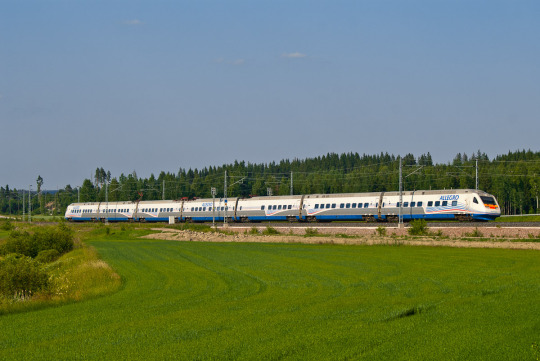
An Sm6 unit on the Kerava-Lahti line, currently the only bit of high-speed rail in Finland, 2011. Teemu Peltonen, Vaunut.org.
Since the 1990s, two daily return trains had been operated between Helsinki and Saint Petersburg, Russia: the Sibelius, which used VR carriages, and the Repin, which used RŽD carriages. In 2006, the two rail operators decided to replace the locomotive-hauled trains, which took five hours to make the trip, with jointly-owned high-speed trains. For this purpose, a new jointly-owned subsidiary Karelian Trains was established.
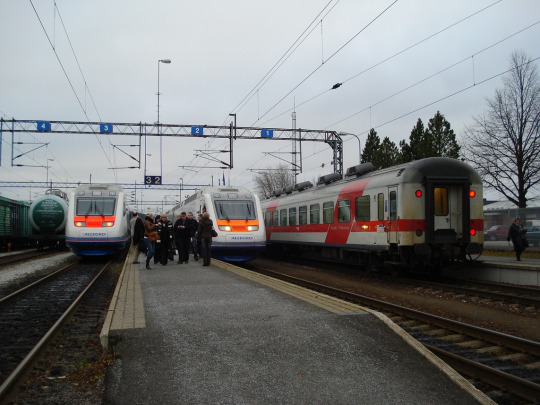
Two Sm6's during pre-service entry test runs at Vainikkala, the border station between Finland and Russia, with the locomotive-hauled St. Petersburg train Sibelius on the right. Lari Nylund, Vaunut.org.
After a round of tenders, Karelian Trains opted for the Pendolino design (already used by VR in the form of the Sm3) from Alstom in 2007, with four units to be delivered in 2010 (there was also an option for two additional units, which was never taken up). Although the exterior design of the new Sm6 units was almost identical to the Sm3, in terms of technology they feature numerous improvements compared to the older class, and were outfitted to operate both on the Russian and Finnish electric systems. Due to the small difference in gauge between the two countries (Russia uses 1520 mm but Finland 1524 mm) the trains were given near-unique gauge of 1522 mm.

Interior of the Sm6's first-class carriage as delivered. Otto Karikoski, Wikimedia Commons.
Branded Allegro, the new Sm6 units begun operations in December 2010, cutting the travel time between Helsinki and St. Petersburg to 3½ hours. In addition to services offered on Sm3 units, the Sm6 has (or perhaps more accurately had) a space for the border patrol to use, as passport control was done en-route on the train, and a kid's playroom. The original grey-dominated interiors were replaced by new, more colourful blue designs in 2018-2019.
The new interiors were not in use for long before the Covid-19 pandemic caused for passenger train services between Finland and Russia to be suspended in March 2020. The Allegro services were restored in December 2021 (the Helsinki-Moscow sleeper train Tolstoy, however, was not), and ran for less than four months until closed again in March 2022 after Russia's invasion of Ukraine. (VR subsequently stopped freight traffic to Russia too - other Finnish rail operators continue to serve freight to and from Russia, however).

Second-class carriage in the post-2019 look. VR.
After March 2022, the four Sm6 units languished at VR's Ilmala depot in Helsinki, without maintenance as RŽD refused to make any payments for their share in Karelian Trains (which, although jointly Finnish-Russian owned, was registered in Finland). In March 2023, when Finnish prime minister Sanna Marin visited Kiev, Ukrainian Railroads requested the Sm6 units be handed over to them, but nothing ever came of this. Instead, in December 2023, when Karelian Trains was on the brink of bankruptcy due to RŽD not paying their share of the company's bills, VR bought out Karelian Trains and took over the Sm6 units.
The trains will be given a thorough technical refit, which will include removal of the systems to operate with Russian electrification, and will enter services on routes within Finland in 2025. How they will be branded is unknown, though a VR representative said in an interview they will not be called Allegro. Presumably this will make the Sm6 the first VR rolling stock class to be fully painted in the new livery.
43 notes
·
View notes
Text
Russia. LV-0233 steam locomotive at the station "Taganrog-II" Паровоз ЛВ-0233 на станции "Таганрог-II"
#2011#june#locomotive#railroad#railway#summer#taganrog#wagons#вагоны#железная дорога#июнь#лв-0233#лето#локомотив#паровоз#паровоз лв#паровоз лв-0233#таганрог#station#город#city#Россия#Russia#Rostov Oblast#Ростовская область#Canon#Canon EOS 550D#flickr#russian tumblr#русский tumblr
8 notes
·
View notes
Text

This is the most distance I’ve seen between a book’s reputation and its content. At best, people talk about Atlas Shrugged like it’s a shoddy story straining under its philosophical burdens, but when I read it, I saw a Russian science fiction novel.
In one scene, a group of government functionaries on a train need to be in California by midnight. Because most of the rail line’s employees were hired for political reasons, all rail lines but one are closed and there is no functioning diesel locomotive. The management, also political, is less concerned about fixing these problems than passing the blame, so the decision of what to do is finally made by a mid-level manager. This manager had a brother who killed himself after his workplace was nationalized by the People, and the news of this suicide was suppressed so as not to damage the People’s morale. Now, the manager orders that the a coal-burning locomotive should pull the train through a tunnel in the Rocky Mountains, a solution that will asphyxiate all its passengers but get their corpses to San Jose on time. “And?” the manager thinks to himself, “who is on that train? I bet it's People.”
I’m going to have to write a longer review of this book.
from my November newsletter
11 notes
·
View notes
Video
L-R: TE2 diesel, the O, L and LV types of the steam engines on exposition in the Russian Railways museum at St Petersburg por Cetus13 Por Flickr: The "O" (О) class engine of Russian/Soviet railways was the first basic / standard (that mentioned in the name – Osnovnoy) 0-8-0 class locomotive designed in Russian Empire. It was was produced in great quantity by 12 plants of three countries (Russia, Germany and Austria-Hungary) with 9129 produced from 1890 until 1928 yy. It was the first Russian engine that obtained perspective compaund steam machine (in variant of the cross compaund - note the difference of cilinders on each side). Surprisingly, the fuel consumption exceeded that of the previous type Ch of the same 0-8-0 class having simple steam machine so during all production time many attempts to reduce excessive fuel consumption were made. On the other side, the general simplicity, fuel versatility and low axle load (13-14 t) with strong frame made it great for any railways. In addition, the low weight with high power (550-720 hp) was good for armory so it was standard locomotive for armored trains of Red army. The L type of Soviet freight steam locomotives 2200 hp of 2-10-0 class with maximum speed 85 km/h (53 mph) and tractive effort 271.5 kN (61,040 lbf) were developed during WW2 on the Kolomna Locomotive works under supervision of famous designer L.C. Lebedyanski (P type were renamed to L in the honor of the constructor). They were produced from 1945 to 1955 yy in Russia by the Kolomna Locomotive Works (##0001-1000 and 1501-2385) and Bryansk Machine-Building Plant (##1001-1389), also in Soviet Ukraine on the Voroshilovgrad Locomotive works (##4001-5307) with total production 4199 ones. LV locomotive of the 2-10-2 class was the last and more powered variant of L class developed to 1949 y which boiler was increased and frame hardened - general frame elongation and increased weight needed addition of the trailing wheel. The fuel efficiency was the highest but the time of steam engines was going to end so only 522 was built from 1952 to 1956. Also the structural length of LV with original tender equipped with 3-axle bogies was excessive for many railways and turntables so some were used with shorter 8-wheel tender (as seen in the museum).
11 notes
·
View notes



